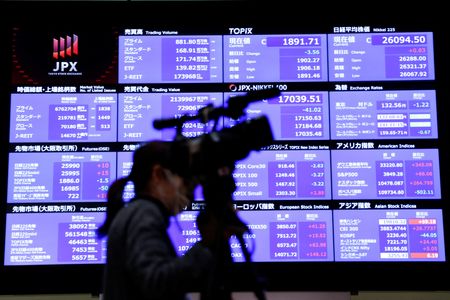By Rae Wee
SINGAPORE (Reuters) -Asian shares and global stock futures tumbled on Wednesday, led by a heavy decline in technology names and as worries about the global growth outlook drove investors out of risky assets, while oil prices hit multi-month lows.
Stock benchmarks in Tokyo and Taipei led the slump in Asia, each falling more than 3%, while MSCI’s broadest index of Asia-Pacific shares outside Japan was last 1.6% lower.
September has historically been a bad month for stocks, though analysts pointed to a confluence of factors behind the rout, including tepid U.S. manufacturing data.
Wall Street closed sharply lower overnight after the U.S. returned from a holiday at the start of the week, with AI darling Nvidia tumbling a record $279 billion as investors reined in their enthusiasm about artificial intelligence.
“The air of portfolio de-risking as the U.S. cranked back up after the Labor Day holiday was seen across all areas within the capital markets,” said Chris Weston, head of research at Pepperstone.
“Growth concerns were the key theme on the day, with cyclical-sensitive assets smacked and hedges laid down aggressively.”
The Nvidia rout spilled into tech stocks in Asia on Wednesday, with Japanese chip-testing equipment maker Advantest, a supplier to Nvidia, down 7%. Taiwan’s TSMC fell more than 4%, while South Korea’s SK Hynix slumped 6.8%.
U.S. stock futures meanwhile extended declines. S&P 500 futures eased 0.4%, while Nasdaq futures shed 0.56%.
EUROSTOXX 50 futures slid 0.93% and FTSE futures declined 0.74%.
“(There) was plenty of blame to go around. Nvidia. Tech. Soft spots in U.S. data. China gloom,” said Vishnu Varathan, head of macro research for Asia ex-Japan at Mizuho Bank.
Recent data from China pointed to an economy that’s still struggling to mount a solid recovery, raising calls for further stimulus from Beijing.
Worries over the sluggish outlook in China – the world’s biggest oil importer – have in turn further exacerbated the decline in oil prices due to expectations of weakening demand. [O/R]
Brent crude futures bottomed at $73.14 a barrel on Wednesday while U.S. crude hit a trough of $69.72, both their lowest levels since December. They had fallen nearly 5% in the previous session.
Elsewhere, stocks in Hong Kong fell in line with their regional peers with the Hang Seng Index down 0.9%.
China’s CSI300 blue-chip index lost 0.15%, while Japan’s Nikkei last traded 3.3% lower.
DATA DUMP
A slew of U.S. economic data is due this week, including figures on job openings, jobless claims and the closely watched nonfarm payrolls report out on Friday.
Given the Federal Reserve’s labour market focus, Friday’s release could decide whether a rate cut expected this month will be regular or super-sized.
“Everyone’s been cheering on the idea of rate cuts, but the idea of having a rate cut isn’t a great thing because it means things are worse economically than what might have been the case,” said Tony Sycamore, a market analyst at IG.
Ahead of the releases, moves in currencies and U.S. Treasuries were less dramatic than those seen in equities, though safe-haven currencies like the dollar and the yen were buoyed by safety bids.
The yen was last steady at 145.43 per dollar, while a rebound in the greenback pushed the euro further away from a 13-month high. The common currency last bought $1.1053.
“I think it looks a little bit treacherous, the week ahead,” said Sycamore.
The Australian dollar was on the defensive, falling 0.16% to $0.67005, further pressured by weakness in commodity prices and as data on Wednesday showed Australia’s economy stuck in the slow lane last quarter.
The benchmark 10-year U.S. Treasury yield fell about one basis point to 3.8329%, while the two-year yield fell slightly over two bps to 3.8630%.
In commodities, spot gold rose 0.07% to $2,494.47 an ounce. [GOL/]
(Reporting by Rae Wee; Editing by Sam Holmes)





